Two months ago, I had a workshop about teaching in learning. You can always head to youtube or tune into any podcast station to watch the episode. As an educator of people, I understand that I also need to create a more in-depth guide to help people understand the final parts of how we learn. We may know how we learn, but we will stay where we are in life until we know how we learn best. The reason is that if you only know how you learn, it will not be enough to help you reach a new and better place in life. This stems from a lack of direction, procrastination, and attaining an advanced level of thinking. In this month’s Tune-Up Series, I will break down the fundamentals of how we learn and start to think in a more refined manner.
The Fundamentals of Learning
-
Auditory
-
Visual
-
Kinesthetic (Hands-on/Body)
Auditory Learning
An auditory learner is a person who will learn and retain information best when information is delivered by sound or speech. When I talk about this type of learning, I find it funny that people are always instantly saying, “I am this type of learner.” This stems from growing up because this is one of the top two ways we learn as children. However, that does not mean it will be our primary learning method. There are many theories on why people favor one fundamental of learning over the other. I chalk it up to the fact that is how your brain became wired in the developmental stages.
Your brain is going to wire according to your environment when you are young. Think about the concept of going without. If you grew up in an impoverished area, you would learn to be without many of the amenities that we have today—for example, clean running water, electricity, and internet. The brain might not know anything about these until it is made aware. That is what happens when we are learning under these fundamentals. In the case of auditory learning, you may have had a noisy environment that developed the brain to ignore sounds as being of foremost importance. You may have had parents who didn’t speak much, think of Buddhism, and how they meditate and go hours or days without talking.
Even with our brains naturally developing in this manner, when we reach adulthood, we can make an effort to strengthen any of these learning methods. To reinforce auditory learning, we can listen to more people speak, especially from different countries with an accent. This will require your brain to pay attention more closely to what they say, in turn, strengthening your listening skills. If you speak with them, you will have to speak more fluently and at a slower pace, forcing the brain to focus on the output. The best way I can explain this is by using martial arts as an example. Before you start making moves like Jackie Chan, you have to start slow. When you slow things down, you become more aware and learn deeper.
You are an auditory learner, and you are looking to find ways to enhance your skill. My best method to reach an auditory learner is to say the same things in different ways. For example, let’s go, come on, hurry up, are you ready, etc. By giving the same information in different ways, I increase the likelihood of retention. This method can be used for non-auditory learners, but it will significantly affect someone who prioritizes auditory-type learning. It would make no sense to keep asking someone the time, and they have no watch. The same is true for trying to force someone to alter their learning method because that is not how you learn. Teaching is more than what works for you instead, trying to figure out what works best for the student or client.
Visual Learning
A visual learner is someone who will learn best through optical means. These people prefer looking at things to absorb information rather than the other two teaching methods. This is another prime learning method we utilize as children. When we are born, we only have two fears. The first is the fear of loud noises, and the second is the fear of falling. Any other fear you have in your life is because you put it there. If you have ever held a baby while a loud noise accrued, you will feel that the baby jolts. That is because the brain associates loud noise with danger. Like how when hearing the wind pick up, seeing the sky turn dark, and hearing thunder in the distance, we use our senses to protect ourselves.
When you have visual learners, they are going to be a step behind until they gain experience. For example, if someone is angry and is likely to harm you or another, there are signs the person will display. A visual learner will be keener at picking up these cues. If they have anger in their voice, then auditory will trump. Nonetheless, each of these will require experience to make an appropriate assumption. A visual learner is someone who has to see it happen first. Even when they see it, they might have to see it a few more times before solidifying the information they received.
As a visual learner, you will learn best by reading and watching. You can use any method to accomplish this task. However, you will have to be mindful of the information coming in. That is because visual learning is one of the quicker-paced learning methods. Please think of how many hours we can sit in front of a television and be. We can take a large amount of content in easily. This promotes two problems: we are amassing unnecessary data, and secondly, we are not proactive in the knowledge received. I do not know many people who watch TV with a pen and pad.
In my experience as a teacher, visual learners get the short end of the stick in the middle stages of life. When we are young, we have time and patience on our side. Whether we are learning our numbers, colors, or ABC, we are cared for until we know the information. However, as we grow, the world demands that we operate more rapidly, so we have to forgo multiple inputs because it would eat up our time. I know this best because I am a visual learner myself. I learn best when I see what is presented AND I have time to run it through my head several times. If I do not have the chance or enough information to repeat the visualization in my mind, I will not develop proficiency.
Visual learners don’t always have to have things repeated to them. Similar to any learning method, you can use mimicry to accomplish a task. I use this primarily in auditory and kinesthetic learning because they are my weak points. Mimicry will allow you to do what was shown, said, and done to you and immediately replicate it. You may need some tweaks, but this has the lowest retention rate unless practiced consistently after mimicking.
Kinesthetic Learning
If you are a kinesthetic learner, you are someone who needs to be hands-on in the learning process. This also includes the totality of your body. These people use movement as a way to retain and recall information. That is why you will sometimes see a student who is antsy at their desk in school. They need to have movement to learn efficiently. These students often get a bad rep for being problem children because they won’t sit still. If someone is a kinesthetic learner, being a hands-on student is not the student’s fault; that is just how they are wired. It is our responsibility as educators to find out and modify the learning process for these children.
Kinesthetic use touch and the body to transfer information. This learning is the weakest learning method, but I understand it, and when I have a student or client that learns this way, I know how to go about it. The sensory you receive when you touch or move your body a certain way stems deep from the psychology of the body in mind. I have years of experience in this field, working with special education students for over three years. In those years, I have learned more about teaching than in my years in college. The main reason was that this type of learning was foreign to me besides reading it in books. Now that I was in the classroom and needed to be hands-on with these students, I found an appreciation for this learning type.
This learning type is curious and explorative. These young minds can be the most outstanding scientist and scholars in the world if they are molded correctly. They are brilliant and can be a breath of fresh air when nothing else seems to be working. I make sure to implement this type of learning in every class or meeting. A sensory break for movement will revitalize and energize the mind enough to continue to learn beyond how we typically learn in a general classroom setting.
If you can put one and two together, you will know this type of learning will be related to the arts, but not the general studies of school. We are operating in a different sphere of the brain, which means that we need to think more intrinsically with these learners. As adults, we must understand that touch is powerful, but you must know how to implement this learning to help them grow and succeed. The best way to do this is to create a space where learning can be trial and error. If they make a mistake, show them it is not the end of the world and no one is judging them (opposite of what society naturally does).
This learner type will require the correct type of teacher/boss for the job. Being a hands-on type of learner requires them to experiment with new ways and methods. That way, they can see if something will stick or if it is not going to work for them. I do this type of process in the early stages of coaching clients. I want to see their work out in their minds how things have not been going their way. Often, people are so deep in denial and have created a rooted belief that is not conducive to growth. I use a kinesthetic method to begin the change process because words and visuals are not always enough to get people to implement the last and most beneficial change in their lives.
In Closing, there is no learning method that is superior to another. Think of someone who is blind, deaf, or born without any arms or legs. Their body strengthens what they have to increase the likelihood of survival. When it comes to preserving and keeping us safe, the brain is more than efficient at the task. However, there are many primitive functions that the brain does not need to implement anymore in our current society. Though learning and intuition are hardwired through evolution, we can seek to change how our brain operates. We must understand how we learn and then implement methods to make learning streamlined and proficient.
Until then,
Michael Rearden
Founder of Reven Concepts
-
Pursuit of Unconscious Competence30 Jun 2024 Mindset Coaching
-
Love, Hate, & Indifference: Navigating Emotions in Relationships23 Jun 2024 Relationship
-
T.U.S Part 59: The Art of Perfectionism16 Jun 2024 Tune Up Series
-
Instant vs. Constant Control: A Perspective on Influence and Critical Thinking09 Jun 2024 Mindset Coaching
-
Doublethink: Warning in Today's World02 Jun 2024 Mindset Coaching
-
The Web of Societal Conditioning: True Self Vs. Indoctrinated Self26 May 2024 Mindset Coaching

